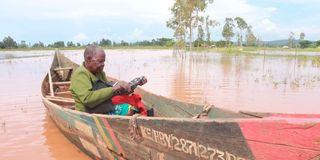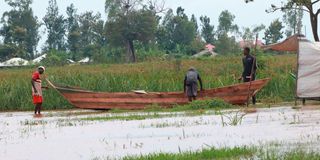Whistles at night: How a simple tool is saving lives in flood-prone villages

Jennifer Auma being rescued from her home in Simbi Kogembo Village, Homa Bay County after it was flooded on May 13, 2025.
What you need to know:
- The frequency of out-of-season flooding has increased by 38 per cent in the Lake Victoria basin over the past five years, creating new challenges for predictive systems and community preparedness.
Jennifer Auma was sound asleep on Monday night when she was woken up by whistling sounds piercing the darkness from different directions across her village. The 70-year-old widow immediately recognised this signal—a warning that she should leave her home and move to higher ground as disaster was about to strike.
"The whistle is a warning that floods are coming and people should leave immediately before water levels rise and make movement difficult," explains Auma, who lives in Simbi Kogembo Village in Rachuonyo North, Homa Bay County.

Residents of Simbi Kogembo Village in Rachuonyo North, Homa Bay County assemble a fishing boat, which they use to move around the neigbourhood during floods, on May 13, 2025.
This simple alert system—a network of community members armed with whistles—represents a life-saving innovation in a region plagued by increasingly unpredictable and devastating floods. It also illustrates how low-tech, community-based early warning systems can effectively complement more sophisticated meteorological forecasting to protect vulnerable populations.
A history of recurring disasters
Simbi Kogembo and neighbouring areas within Rachuonyo North have experienced perennial flooding for generations. Every year, hundreds of families abandon their homes to seek refuge in designated flood rescue centers, primarily schools and churches that sit on elevated ground.
Most residents, including Auma, typically relocate to Simbi Kogembo Health Centre during flooding events. There, they erect temporary shelters and remain for weeks until water levels recede enough to allow their return home.
The flooding in this region occurs when River Kibuon, which drains into Lake Victoria, overflows its banks. Remarkably, residents report experiencing floods even when no rainfall occurs locally as water from upstream areas eventually makes its way to their village. More concerning is their observation that flood intensity has been increasing every year.
"In the past, flood water would percolate into the ground within a few days," explains Elijah Otieno, a longtime resident of Simbi Kogembo. "Now it's taking longer for residents to get back to their normal activities after flooding."
Simbi Kogembo Village experienced flooding beginning on May 12—an unusual occurrence, as residents typically expect floods during the onset of long rains in March and April. Sometimes, homes in the area are flooded twice annually, including during the short rains in October and November.
According to the Kenya Meteorological Department's Regional Flood Monitoring Report (2025), the frequency of out-of-season flooding has increased by 38 per cent in the Lake Victoria basin over the past five years, creating new challenges for predictive systems and community preparedness.
From phone calls to whistles: Evolution of a warning system
The whistle alert system that woke Auma represents an innovative yet elegantly simple community response to the increasing flood risk. At the beginning of 2025, the community designated specific individuals with the responsibility of alerting others when floodwaters begin to rise.
This system is particularly crucial during nighttime flooding events, when water can silently inundate homes while residents sleep, creating potentially life-threatening situations.
Jane Aoko, who chairs the disaster committee in Simbi Kogembo, explains that previous alert systems had significant limitations. "In the past, the team that raises the alarm would use mobile phones to call neighbours and alert them of imminent danger," she says.
However, this approach proved both expensive and ineffective. "Sometimes I would have Sh100 airtime and it was not enough to call everyone and alert them about floods. Some people would also take long to answer their phones while others switch them off, and we would not communicate," Aoko recounts.
The idea of using whistles came from the Kenya Red Cross, which supports community disaster response throughout the region. The organisation provided whistles to Aoko and other community disaster management committee members, who keep them tied around their necks, ready for immediate use during emergencies.
When flood alerts are received or when committee members observe rising water levels, they blow their whistles in a distinctive pattern that signals residents to evacuate. The sound carries across the village, even in the darkest night or heaviest downpour, serving as an unmistakable alarm that requires no electricity, network coverage, or technological literacy.
"I just blew the whistle alongside other officials in the disaster management committee. Within a few minutes, most residents were out of bed and alert," Aoko says of the May 12 flooding event.
Community coordination in action
The whistle system does more than simply alert—it creates a structured evacuation response. When residents hear whistles, they follow the sound and gather at a predetermined assembly point before proceeding together to the designated rescue center.
"During assembly, we brief them on a few safety issues," explains Aoko, noting that this collective approach ensures vulnerable community members are accounted for and assisted if needed.
The Kenya Red Cross has supplemented the whistle system with additional tools. Samuel Omondi, Homa Bay County Kenya Red Cross Coordinator, confirms that disaster committees in Simbi Kogembo, Osodo, and Kobala in Wang Chieng ward have been equipped with megaphones to amplify warnings and communication during evacuations.
"All of them have gumboots, wheelbarrows, and shovels, which they use during floods. They have been trained on how to use the tools, and having them has improved disaster preparedness," Omondi explains.
According to the Kenya Red Cross Homa Bay Response Assessment (2025), villages implementing these community-based warning systems have seen evacuation rates improve by 64 per cent compared to previous years, with a corresponding 43 per c4en4t reduction in flood-related injuries.
When warnings aren't enough: The limits of alert systems
Despite the effectiveness of the whistle system, not all residents manage to evacuate in time. Auma herself was among those who required rescue during the May flooding event despite hearing the warning whistles.
"I was alerted about floods but could not move out on time. By the time I got out, the entire house was flooded, and I didn't want to risk stepping out," she recounts.
The following day, Kenya Red Cross rescuers used fishing boats to reach her marooned home and evacuate her safely. For some time, she had tried using containers to scoop and remove water seeping through cracks in her walls, but the effort proved futile as inflow exceeded what she could remove.
Her experience highlights an important limitation of warning systems: alerts alone cannot protect vulnerable populations without corresponding evacuation capacity, particularly for elderly or disabled residents who may require assistance.
A 2024 study by the University of Nairobi's Institute for Climate Change and Adaptation found that approximately 22 per cent of residents in flood-prone areas of Western Kenya face significant mobility challenges during evacuations, with elderly women like Auma among the most vulnerable groups.
The growing challenge: climate change and increasing flood risk
Environmental experts indicate that Homa Bay and similar regions will continue experiencing floods with increasing frequency and intensity due to climate change effects.
Clifford Omondi, an environmental scientist specialising in climate adaptation, explains that climate change has caused rainfall intensity to increase, overwhelming natural drainage systems.
"Soil becomes saturated when there's too much rain. Water cannot infiltrate into the ground, and it causes flooding downstream," he explains.
In Homa Bay's geography, this problem is compounded by the fact that major rivers originate in highland areas. When continuous rainfall occurs upstream, runoff from these elevated regions cannot percolate into already-saturated ground. Instead, all that water channels into rivers and eventually floods lower-lying areas like Simbi Kogembo.
According to the Kenya Meteorological Department's Climate Change Projection Report (2024), the Lake Victoria basin is expected to see a 27 per cent increase in extreme precipitation events by 2030, even as overall annual rainfall patterns become more erratic and unpredictable.
"What was expected before is not what is happening. We have rainfall patterns that are very variable and may not be regular as has always been expected. Floods can occur within a short period after it rains because of the soil's inability to withstand the water," Omondi notes.
This variability poses significant challenges for traditional knowledge systems that rely on regular seasonal patterns, making community-based observation networks and rapid response capabilities even more critical.
Structural solutions: beyond warning systems
While early warning systems save lives, residents and experts agree that more permanent solutions are necessary to address the root causes of flooding.
Elijah Otieno points to siltation at the river mouth as a key factor preventing proper drainage. "The river mouth has a lot of silt. This makes it difficult for water to drain into the lake without spilling into homes," he observes.
He advocates for dredging and construction of dykes along River Kibuon to control floods—infrastructure interventions that would complement warning systems by reducing the frequency and severity of flooding events.
The National Water Conservation and Pipeline Corporation conducted a feasibility study in 2023 that identified 17 critical points along River Kibuon requiring intervention, estimating that comprehensive dyke construction would reduce flooding in Simbi Kogembo by approximately 75 per cent (NWCPC Flood Mitigation Report, 2023).
However, funding for such projects has been limited. The Homa Bay County Government allocated Sh35 million for flood mitigation infrastructure in its 2024/2025 budget—only about 20 per cent of what experts estimate would be required for comprehensive protection of vulnerable communities.
Mr Omondi emphasises that addressing flooding requires a comprehensive strategy that goes beyond immediate response measures.
"We need to do all that is required to ensure that we mitigate the serious effects of climate change. Floods interfere with the social setup of families, and it should be controlled," he urges.
He advocates for increased tree planting and improved agricultural practices throughout watersheds to enhance soil water retention and reduce runoff
For Jennifer Auma and her neighbours, the simple whistle has become a symbol of community solidarity and resilience in the face of increasing climate threats—a sound that, though it heralds danger, also represents hope that even the most vulnerable communities can adapt to our changing world.


